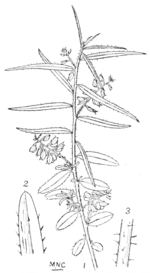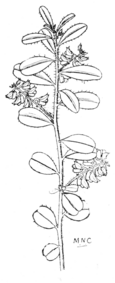The Journal of Indian Botany/Volume 1/October 1919/A note on certain species of Polygala
A NOTE ON CERTAIN SPECIES OF POLYGALA
BY
K. Rangachariar, m.a., and C. Tadulingam, F.L.S.
Agricultural Research Institute, Coimbatore.
During the month of December last year some species of Polygala came up in great profusion and they were unusually dominant on the Estate of the Agricultural College. They consisted of the four species dealt with in this note. Out of these four, only one, Polygala chinensis L. is included in Hooker's Flora of British India, and in Gamble's Madras Flora this species and Polygala bolbothrix Dunn are included. The other two species are merged under Polygala erioptera, DC. Prod. i. 326 and Polygala chinensis Linn., although they differ very much from these species. In Wight and Arnott's Prodromus 1.36, Polygala Vahliana DC. is treated as a distinct species.

Text fig. 1. P.-Vahliana:—A. a branch, 1. flower-bud, 2. an open flower, 3. ovary, 4. corolla, 5. fruit, 6. fruit cut open, 7 seed.
1. Polygala Vahliana DC. Prod. 326:—This is a freely branching herb. Stems and branches are procumbent and pubescent. Leaves are oblong, narrowed downwards into a petiole, obtuse, mucronulate or not, softly hairy on both the surfaces and varying in length from 3/16 to 7/16 inch. Racemes are very short, opposite to the leaves or lateral, 3 to 6 flowered; bracteoles are very small and persistent. The two inner larger sepals are somewhat membranous with a green mid-nerve, elliptic, villous and about as long as the fruit. The petals are pinkish and the keel is cristate. The capsule is very small, oval, emarginate, glabrous on the faces and softly villous at the edges only, 1/8 inch long and 1/16 inch broad. Seeds are narrow, strophiolate and without any appendages.
This plant matches very well with Wight's type specimen No. 131 in the Madras Herbarium named Polygala Vahliana DC. It is quite distinct from Polygala crioptera, DC. 1. 326. and differs from it in several points. Polygala Vahliana, DC. is a prostrate plant with oblong hairy leaves, and it has villous sepal wings and pinkish petals, whereas Polygala crioptera DC. is an erect one with stiff branches and almost glabrous linear leaves and has quite glabrous wing sepals and yellow petals. Specimens of this plant were sent to Mr. Gamble [1] and he now considers this to be a distinct variety of Polygala crioptera. The differences are, we think, quite sufficient to consider this as a distinct species, as is done by Wight and Arnott in their Prodromus.
2. Polygala sp:—This is an annual herb. Stems and branches are mostly procumbent and densely hairy. Leaves are either ovateoblong, obtuse rarely retuse, or oblong-lanceolate to oblong-linear, acute, mucronulate, shortly petioled and with soft hairs scattered on both the surfaces. Racemes are shorter than the leaves, lateral, densely softly hairy with a few to many short pedicelled flowers closely set. The larger inner sepals are greenish with membranous margins, thinly hairy all over, obliquely ovate lanceolate, acuminate, about as long as or a little longer than the capsule. Petals are rose-purple. Capsule is oblong, longer than broad, about ⅛ inch or a little longer, with unequal lobes, oblique and emarginate at the apex, margin ciliate. Seeds are oblong, with a three-fid strophiole without any wings or rarely two arms with very short obscure wings.

 |
 |
 |
| (B) P. arvensis willd. | (C) P. bulbothrix Dunn I. | (D) P. bulbothrix Dunn II. |
This species is no doubt closely allied to Polygala chinensis L., but differs from it in the following respects. The stems and leaves are more pubescent than in Polygala chinensis L., the flowers are smaller than those of the other, rose-purple and not yellow, the wing sepals are pubescent and not glabrous, the capsules are oblong and longer than broad and not rounded and broader than long as in Polygala chinensis L., seeds are oblong and not broadly ovate oblong and plumpy, strophiole is without any wing or rarely with minute obscure wings on two of the arms, not with wings as in Polygala chinensis L.
These differences are sufficient to consider this a distinct species. As the name Polygala arvensis Willd. is a synonym of Polygala chinensis L., a new name should be given to this plant. Specimens of this plant are being sent to Mr. Gamble and to Kew, and after hearing from them this will be named.
This plant appears to be the one described by Wight and Arnott in their Prodromus as Polygala arvensis Willd. var γ. and it is figured in Rheede's Hort. Mai. Vol. 9 t. 61.
3. Polygala bolbothrix Dunn. This is a freely branching annual herb. Stems and branches are diffuse, prostrate and the whole plant is covered with scattered bulbous-based hairs. Leaves are linearoblong to narrowly oblong linear, glabrous, obtuse, mucronate, varying in length from ½ to 1½ inches, margins with distant bulbous-based

cilia, especially so on the lower half. Racemes are extra axillary, twice as long as the leaf or more when fully grown, and many flowered. The two inner large sepals (wings) are membranous-margined, ovate, acute, glabrous and slightly longer than the capsule. The capsule is small, slightly oblique, not margined, glabrous and rigidly ciliated on the margin and emarginate. Seeds are oblong and strophiolate without wings or sometimes the two arms with very obscure wings.
Fig. C., p. 46, 1. branch, 2. a bit of a leaf with cilia, 3. a bit of stem, (D) branch of the broad-leaved form. Text fig. 3. Parts of the flower. 1. flower-bud, 2. open flower, 3. petals, stamens and ovary, 4. ovary, 5, fruit, 6. fruit cut open, 7. seed.
This plant is described as Polygala ciliata (L) by Wight and Arnott in their Prodromus Vol. I p. 38, and it is renamed as Polygala bolbothric by Mr. Dunn (vide Kew. Bulletin No. 3, 1916, p63). The name Polygala ciliata (L) could not be retained as this was applied to a species of Salomonia by Linnaeus. Evidently the plant referred to by Wight and Arnott in their Prodromus cannot be Polygala ciliata L. and the synonym should be Polygala ciliata of W. & A. Prodromus i.38.
The form here described has long linear leaves and this was abundant here. The other form which is more common has ovate or obovate leaves.
4. Polygala chinensis L.—This can be distinguished from the others easily. The flowers of this species are yellow, the fruit is rounded, broader than long, the seeds are ovate oblong, plumpy and the strophiole is provided with well developed wings.

Text fig. 4.—1. flower-bud, 2. open flower, 3. petals and ovary, 4. fruit, 5 fruit cut open, 6. seed.
- ↑ Who is working on the new official "Flora of the Madras Presidency."